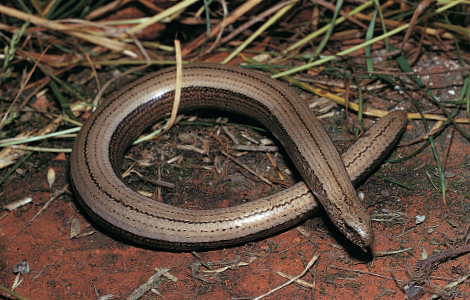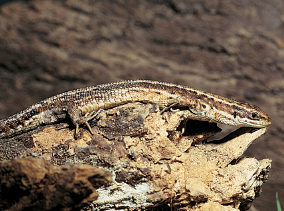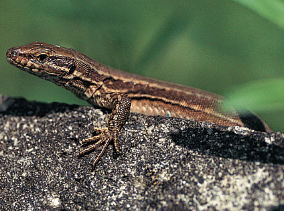
Three species of lizards are native to the British mainland, but only the common or viviparous lizard and the slow worm are likely to occur in gardens. Both are carnivorous, eating a wide range of insects, spiders and other invertebrates.
FEEDING LIZARDS
Most lizards can be tempted with some mealworms (see here). If you have lizards in the garden, put out a saucer of mealworms and sit back and watch the fun. As long as you keep still, you can stay quite close – and then the birds won’t pinch all the worms.
The viviparous lizard is a sun-loving creature and a good way of attracting it to your garden is to leave areas of short grass or bare ground or, better still, a few rocks on which it can sunbathe. Basking is especially important for this lizard because the females give birth to active young and they need warmth for the proper development of the babies. Most other lizards lay eggs. Dry stone walls and log piles are also good places for the lizards, as long as they get some sunshine. They provide warm surfaces for basking, and their numerous nooks and crannies are ideal sleeping and breeding quarters. And, of course, they harbour plenty of tasty small animals.
The slow worm is often mistaken for a small snake, but this legless lizard is fairly easy to recognize by its rather uniform shiny brown colour. Its oval eye, equipped with eyelids, is also very different from the circular eyes of snakes. Not keen on sunshine, the slow worm is most likely to be seen in the evening or after a shower, for this is when the slugs are most active and the slow worm loves slugs! It hunts in hedge bottoms and in long grass at the bases of walls and trees, so try to leave patches of grass for this helpful guest. You may also find it in the compost heap, where it enjoys warmth as well as plenty of slugs.

Michael Chinery
Early morning is a good time to lift slow worm shelters. This is often an ideal opportunity to get a good look at the animals when they are still quite cool and lethargic.
You can encourage slow worms to take up residence in a rough part of the garden by laying down a few pieces of old carpet or some curved roof tiles. These objects make ideal shelters for slow worms because the animals can get comfortably warm without actually exposing themselves to the sun. Lift the shelters occasionally to see the animals; unlike snakes and other lizards, they tend to sit tight when disturbed and are easy to examine. Slow worms give birth to active young and you may find the babies – like shiny pieces of string – under the shelters in the autumn.
Michael Chinery
The green lizard, seen here in a typical basking pose, is easily recognized by its colour. Adults are a much brighter green than the immature individual shown here.
Continental gardens and those in the Channel Islands also support green and wall lizards. With a body about 12cm (5in) long and a tail up to twice as much again, the green lizard is one of our largest species. Each individual defends a territory, often a large clump of grass or other dense vegetation on which it can bask, but the lizards are very touchy and all you usually see is a tail disappearing into the undergrowth. Wall lizards are much easier to watch. Living in and around our houses, they bask on any sunny surface and scamper up and down walls with amazing agility. Give them some old tiles to bask on and, as long as you don’t move too quickly, you will be able to watch them quite easily.

Michael Chinery
The common or viviparous lizard, seen here basking on a sunny log, has a relatively smaller head than the wall lizard pictured below.

Michael Chinery
True to its name, the wall lizard is a great climber, running up and down walls with equal ease and snapping up any spider or insect coming within its range.